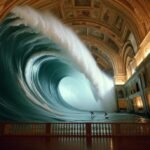Sora represents a significant leap in the field of AI-driven video generation. Developed by OpenAI, Sora is a diffusion model capable of creating highly detailed and imaginative scenes from textual instructions. What sets Sora apart is its ability to generate videos up to a minute long, maintaining both visual quality and adherence to the user’s prompt.
Exploring the Boundaries: What Can Sora Do?
Diverse Duration and Quality
- Length: Sora can generate videos up to a full minute, pushing the boundaries of length in AI-generated content.
- Resolution and Aspect Ratios: It supports various resolutions and aspect ratios, accommodating different formats like widescreen or vertical videos.
Creative Freedom in Content
- Multiple Characters and Motions: Sora can generate complex scenes involving multiple characters and specific types of motion.
- Detail-Oriented: The AI pays close attention to the details of the subject and background, making the scenes more lifelike and convincing.
Language Understanding and Interpretation
- Sora’s deep understanding of language allows it to interpret prompts accurately and generate compelling characters expressing vibrant emotions.
The Limitations: Where Does Sora Fall Short?
Despite its advanced capabilities, Sora is not without limitations.
- Physics Simulation: It may struggle with accurately simulating complex physics in a scene or understanding specific cause-and-effect instances.
- Spatial Details: The model may confuse spatial details in a prompt, like mixing up left and right.
- Temporal Coherence: Precise descriptions of events unfolding over time, such as specific camera trajectories, can be challenging for Sora.
Safety and Ethical Considerations
Before deploying Sora in OpenAI’s products, several safety measures are being implemented. This includes adversarial testing by red teamers, the development of detection classifiers to identify Sora-generated content, and adherence to usage policies to prevent the generation of harmful or misleading content.
Sora’s Technical Backbone
Sora, a diffusion model, starts with noise-like visuals and gradually transforms them over many steps to create the final video. It uses a transformer architecture, which is known for its scalability and effectiveness in handling diverse data types. This technical framework allows Sora to handle different durations, resolutions, and aspect ratios more effectively than previous models.
Real-world Applications: A Glimpse into the Future
The potential applications of Sora span various domains:
- Creative Industries: Film makers, artists, and designers can use Sora to generate unique content, from music videos to concept art.
- Education and Training: Creating realistic simulations for training purposes in fields like medicine or aviation.
- Entertainment: In the gaming industry, for instance, Sora could be used to create dynamic game environments or cutscenes.
Conclusion: A Promising Horizon with Room for Growth
In conclusion, while Sora represents a significant advancement in AI-driven video generation, it’s not yet a tool that can generate “any” type of video flawlessly. Its capabilities in handling diverse content, understanding complex prompts, and generating high-quality videos are unparalleled. However, its limitations in simulating physics accurately and handling detailed temporal sequences indicate areas for future improvement.
As technology progresses, we can expect Sora’s capabilities to expand, potentially overcoming its current limitations and opening new avenues for creative and practical applications. Sora is not just a tool; it’s a glimpse into the future of AI’s role in content creation.
FAQs
Q: Can Sora generate videos longer than one minute?
A: Currently, Sora’s limit is up to one minute of video, but future enhancements might extend this duration.
Q: Is Sora available for public use?
A: As of now, Sora is in a phase where it’s being tested and improved, primarily with input from select professionals in creative fields.
Q: Can Sora generate videos based on real-life footage?
A: Sora primarily generates videos from textual prompts. While it can take cues from existing images or videos, it generates new content rather than modifying real-life footage.
OpenAI’s Sora is a testament to the incredible advancements in AI and its potential to revolutionize the way we create and interact with video content. As it continues to evolve, it’ll be exciting to see the new horizons it opens up in the world of digital creativity and beyond.







